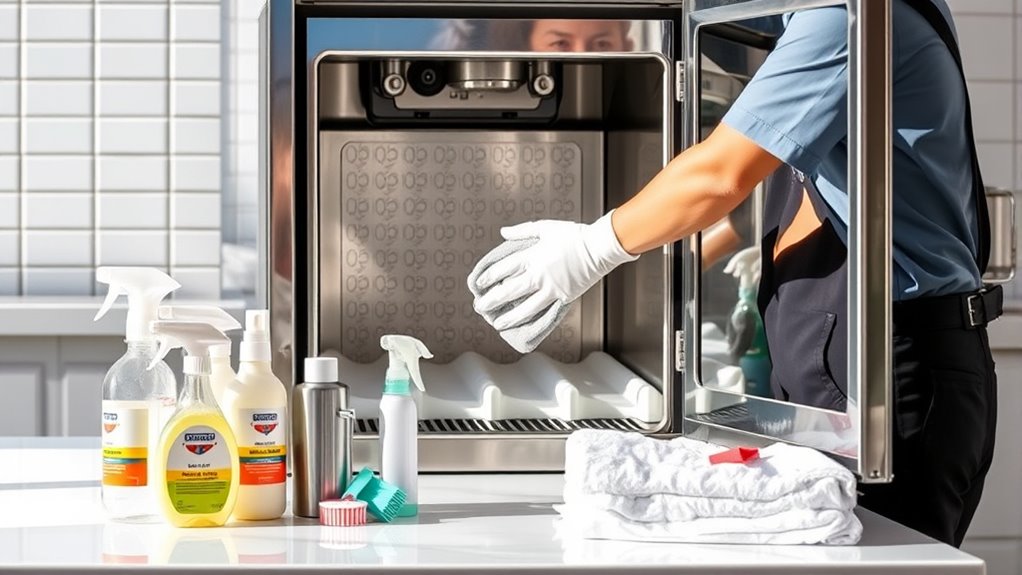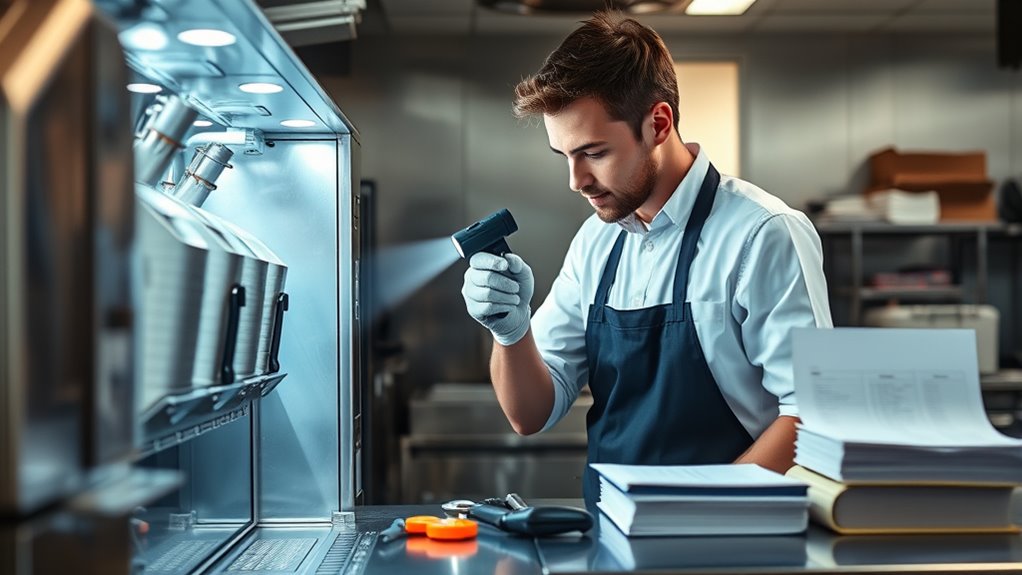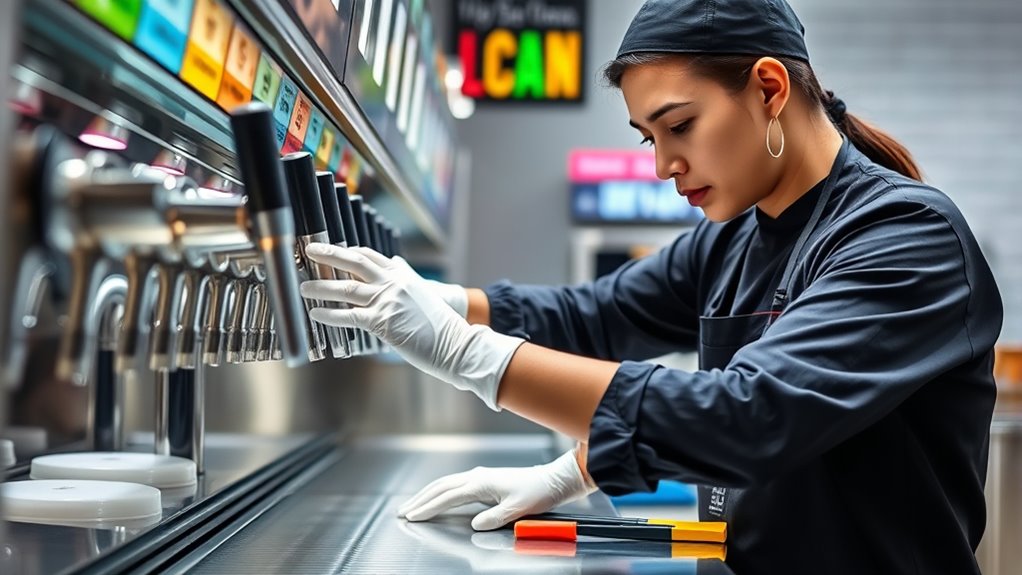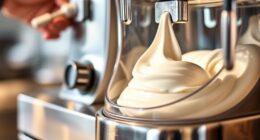To train your staff like pros on ice cream machine best practices, guarantee they understand different equipment types, features, and proper operating techniques. Teach them how to perform daily maintenance, cleaning, and troubleshooting to prevent issues. Emphasize safety and preventative upkeep to extend machine lifespan. Consistent training on quality control and quick problem-solving boosts customer satisfaction. Keep your team updated on innovations and best practices—if you want to master the process, there’s plenty more to learn below.
Key Takeaways
- Provide comprehensive training on different machine types, features, and proper operating techniques for consistent quality.
- Establish and enforce daily maintenance and cleaning routines to ensure hygiene and equipment longevity.
- Educate staff on troubleshooting common issues to minimize downtime and maintain service flow.
- Implement preventative maintenance schedules and safety protocols to prevent accidents and extend equipment lifespan.
- Foster ongoing staff education on product quality standards and technical problem-solving for optimal customer satisfaction.
Understanding Your Ice Cream Machines: Types and Features

To effectively train your staff, you need to understand the different types of ice cream machines and their features. There are several options, from soft-serve machines to batch freezers, each suited to different needs. Soft-serve machines are great for quick service and offer a variety of ice cream flavors, allowing you to cater to diverse customer preferences. Batch freezers produce larger quantities of traditional ice cream, ideal for customizing flavors and serving more customers efficiently. Knowing how each machine operates helps staff troubleshoot issues quickly and select the right equipment for different flavor offerings. Additionally, understanding these machines can help in selecting options that align with health benefits, such as offering nutrient-rich flavors that appeal to health-conscious customers. Being familiar with these machine maintenance procedures ensures minimal downtime and extends the lifespan of your equipment. Proper training on machine operation techniques can improve efficiency and reduce errors during service. Understanding the different machine types and their features also allows you to optimize energy use and reduce operational costs, especially when selecting equipment with higher efficiency ratings. Incorporating knowledge of efficient operation can further help in reducing waste and controlling overhead expenses. By understanding these differences, your team can better recommend options to customers, ensuring their preferences are met and boosting overall satisfaction.
Daily Maintenance and Cleaning Protocols

You need to establish a consistent cleaning schedule to keep your equipment in top shape. Make sure your staff follows proper sanitization techniques to prevent contamination. Daily maintenance checks are essential to guarantee issues early and ensure smooth operation. Incorporating routine health checks can help identify potential problems before they escalate and can also contribute to maintaining the overall hygiene of the equipment. Regular cleaning routines also help reduce bacterial buildup, safeguarding both staff and customer health. Additionally, incorporating grocery savings strategies can help reduce costs associated with equipment maintenance and supplies. Staying informed about the latest AI-powered device innovations can further optimize maintenance routines and improve operational efficiency. Understanding essential oils for oral health can provide insights into natural methods for promoting cleanliness and preventing infections.
Regular Cleaning Schedule
Establishing a daily cleaning schedule is essential for maintaining a safe and efficient work environment. You need to determine the right cleaning frequency to prevent buildup and ensure proper hygiene. Assign clear staff responsibilities so everyone knows their role in the process. For example, one team member can handle wiping down surfaces, while another cleans the drip tray and exterior parts. Consistent routines help prevent cross-contamination and keep the machine in top condition. Make sure your staff understands their tasks and follows the schedule diligently. Regular cleaning not only promotes cleanliness but also extends the lifespan of the equipment. Understanding air purifier maintenance dos and don’ts can help staff recognize proper procedures and avoid common mistakes that could compromise the equipment’s performance. Incorporating effective training practices ensures staff remain knowledgeable about best maintenance protocols. Familiarity with personal finance management principles can also enhance their ability to budget for supplies and maintenance costs effectively. Additionally, emphasizing the importance of consistent sanitation efforts reinforces the need for ongoing diligence. By establishing these protocols, you create a safer environment and improve overall efficiency in your operation.
Proper Sanitization Techniques
Are your staff following the proper sanitization techniques during daily maintenance? Ensuring thorough sanitization is key to preventing contamination and maintaining quality. Equip your team with the right sanitization tools, such as brushes, cloths, and spray bottles, and teach them how to use cleaning solutions effectively. Always start by disconnecting the machine and removing removable parts. Apply cleaning solutions to all surfaces, paying close attention to hard-to-reach areas. Use brushes to scrub away residue and sanitize tools regularly to avoid cross-contamination. Rinse thoroughly with clean water, then dry all parts completely before reassembling. Proper sanitization not only keeps your ice cream machine safe but also prolongs its lifespan. Incorporating body awareness techniques can help staff stay attentive to proper procedures and prevent overlooked areas during cleaning. Additionally, understanding machine maintenance best practices can further improve the longevity and performance of your equipment. Regular staff training on proper protocols ensures consistency and effectiveness in cleaning routines. Staying informed about resources and tools available for maintenance can help your team adopt new techniques and improve efficiency. Make sure your staff is trained to follow these protocols consistently for ideal results.
Daily Maintenance Checks
Implementing daily maintenance checks is essential to keep your ice cream machine running smoothly and to prevent potential issues. Start each day by inspecting the machine installation to ensure all parts are secure and functioning correctly. Check the ice cream flavoring lines for any blockages or buildup, which can affect taste and texture. Clean and sanitize all removable components, including the hopper and dispensing nozzles, to prevent bacterial growth. Verify that the refrigeration system maintains proper temperatures, avoiding spoilage or ice buildup. Regularly examine the mix supply and ensure the machine’s internal parts are free of residue or clogs. Additionally, staying aware of maintenance and troubleshooting can help you implement safeguards against potential digital threats to your equipment. Performing these routine checks helps maintain product quality, prolongs equipment lifespan, and ensures your staff can serve delicious, consistent ice cream every time. Proper digital literacy among staff can further enhance your ability to quickly identify and resolve technical issues. Incorporating software quality assurance best practices into your maintenance protocols can also help streamline troubleshooting and improve overall operational efficiency. Being familiar with common technical issues and their solutions allows your team to respond swiftly to unexpected problems, minimizing downtime.
Proper Operating Techniques for Consistent Quality

To achieve consistent quality, mastering proper operating techniques is essential. You want every batch of ice cream to deliver flavor consistency, ensuring customers return happily. Always start by pre-chilling the machine to the correct temperature, which helps maintain smooth texture and prevents melting issues. When filling the hopper, avoid overfilling; this keeps the machine running efficiently and prevents clogging. During operation, monitor the mix flow and adjust settings as needed to maintain the ideal consistency. Regularly clean and sanitize the machine after each use to prevent flavor contamination. Consistent procedures like these ensure each serving meets quality standards, boosting customer satisfaction. By following proper operating techniques, you minimize variations and deliver a reliably delicious product every time.
Troubleshooting Common Machine Issues

Even with proper operating techniques, machine issues can still arise and disrupt your workflow. When troubleshooting common problems, start by checking key components like the compressor, air system, and dispensing mechanisms. Component troubleshooting helps identify whether a worn-out part or clog is causing the issue. Clear customer communication is essential; inform your staff to stay transparent and reassure customers during downtime. If the machine won’t chill, verify the thermostat and refrigerant levels. For inconsistent dispensing, inspect the nozzle and pump. Regularly cleaning and inspecting parts can prevent recurring problems. Remember, quick identification of component issues saves time and reduces frustration. Staying calm and methodical ensures you resolve issues efficiently, minimizing customer inconvenience and maintaining high service standards.
Implementing Preventative Maintenance Schedules

Establishing a preventative maintenance schedule is crucial for keeping your equipment running smoothly and avoiding costly downtime. Regularly check and perform machine calibration to ensure consistent ice cream quality and prevent operational issues. Incorporate routine inspections into your schedule, focusing on key components like compressors, motors, and nozzles. Effective inventory management is also essential; keep a stock of necessary parts and cleaning supplies to avoid delays. Assign specific tasks to staff members and set reminders for maintenance intervals, such as cleaning, checking pressure levels, and lubrication. By staying proactive, you reduce the risk of unexpected breakdowns and extend your equipment’s lifespan. A structured schedule keeps your team organized and ensures that maintenance becomes a seamless part of daily operations.
Training Staff for Safety and Best Practices

Training your staff on safety and best practices is essential for maintaining a secure and efficient work environment. When your team understands proper procedures, you reduce accidents and equipment mishaps, ensuring smooth operations. Listening to customer feedback helps identify areas where safety protocols need reinforcement, boosting staff motivation as they see their efforts improve service quality. Regular training sessions keep everyone updated on safety standards and best practices, fostering a culture of accountability. When staff feel confident and well-informed, they’re more likely to take initiative and adhere to protocols. Encouraging open communication about safety concerns also builds trust and engagement. Ultimately, investing in exhaustive training not only protects your team but also enhances customer satisfaction, making safety a core part of your ice cream shop’s success.
Frequently Asked Questions
How Often Should Staff Be Retrained on Machine Operation?
You should schedule staff refresher training on machine operation at least every six months to guarantee skills stay sharp. Regular training keeps your team updated on best practices and helps prevent errors. Incorporate a consistent training schedule, adjusting it based on staff experience and machine updates. This proactive approach boosts efficiency, maintains product quality, and reduces downtime, making your staff confident and well-prepared to handle the equipment effectively.
What Are Signs of Imminent Machine Failure to Watch For?
Your ice cream machine gives warning signs when it’s nearing failure, and ignoring them is like playing with fire. Watch for inconsistent freezing, strange noises, leaks, or unusual odors—these are clues that machine maintenance is needed. Operator vigilance is essential; stay alert to these signs to prevent breakdowns. Regular checks and prompt maintenance keep your machine running smoothly and save you from costly repairs down the line.
How Can I Optimize Ice Cream Consistency During Peak Hours?
To optimize ice cream consistency during peak hours, focus on maintaining proper ice cream texture by monitoring temperature and guaranteeing your machine is well-maintained. Regular machine maintenance prevents issues that can impact texture, like freezing inconsistencies. Keep the mix chilled and clean the machine frequently to ensure smooth operation. By staying proactive with maintenance and monitoring, you’ll serve consistently high-quality ice cream, even during busy times.
Are There Recommended Tools for Effective Machine Troubleshooting?
Oh, surely you’ve got a magic troubleshooting wand, right? Well, in reality, effective tools include a solid troubleshooting checklist and tools for preventive maintenance. These help you quickly identify issues and prevent future breakdowns. Invest in reliable gauges, cleaning kits, and diagnostic software—because no one has time to guess when your machine’s acting up. Proper tools keep your staff confident and your ice cream flowing smoothly during the busiest hours.
How Do I Handle Machine Calibration Adjustments Safely?
When handling calibration adjustments, prioritize safety by following proper procedures. Always turn off the machine before making any calibration safety checks or adjustments. Use the manufacturer’s guidelines to guarantee correct calibration procedures, avoiding guesswork that could damage the equipment or cause safety hazards. Carefully monitor the machine during adjustments, and double-check settings afterward. Proper training and adherence to adjustment procedures protect both your staff and the machine’s performance.
Conclusion
Now that you’re equipped with these ice cream machine best practices, you’re the maestro behind the creamy symphony. With each clean, tweak, and troubleshoot, you’re sculpting a masterpiece of smooth, delicious treats. Think of your staff as skilled artisans, turning everyday equipment into a fountain of joy for your customers. Keep the rhythm steady, and watch your ice cream operation flourish like a well-orchestrated melody—sweet, seamless, and unforgettable.










